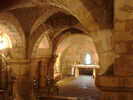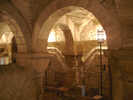

Lastingham Abbey went through two incarnations. It was originally founded in 651-655 during the early days of Christianity in Anglo-Saxon England, and was ruled by St. Cedd and then his brother St. Chad. This abbey was ruined by 1066, and a new abbey was founded on the same site in around 1078 by monks from Whitby, but this second foundation was very short-lived and the monks had moved to York by 1086.
 The first abbey at Lastingham was founded by Ethelwald, son of Oswald, king of Deira, in around 651-655, with the help of St. Cedd, bishop of the East Angles. The location was described by Bede as being 'amongst mountains, difficult of access and remote, where appeared to be fitter dwelling-places for thieves and wild beasts than for men'. It used a similar rule to Lindesfarne, and St. Cedd was its first abbot. He died of the plague in 664 and was succeeded by his brother, St. Chad, the bishop of the Mercians. During's Chad's time as abbot the first stone church was built and his brother's grave was moved from the churchyard to the new church. Chad was active across much of Anglo-Saxon England, but he retained his connection with Lastingham and monks from the abbey played the part in the foundation of a new monastery at Lichfield. Chad died in 672 but the monastery outlasted him. We don’t actually know when it was abandoned, but the standard story is that it was destroyed by Viking raiders, possibly towards the end of the ninth century.
The first abbey at Lastingham was founded by Ethelwald, son of Oswald, king of Deira, in around 651-655, with the help of St. Cedd, bishop of the East Angles. The location was described by Bede as being 'amongst mountains, difficult of access and remote, where appeared to be fitter dwelling-places for thieves and wild beasts than for men'. It used a similar rule to Lindesfarne, and St. Cedd was its first abbot. He died of the plague in 664 and was succeeded by his brother, St. Chad, the bishop of the Mercians. During's Chad's time as abbot the first stone church was built and his brother's grave was moved from the churchyard to the new church. Chad was active across much of Anglo-Saxon England, but he retained his connection with Lastingham and monks from the abbey played the part in the foundation of a new monastery at Lichfield. Chad died in 672 but the monastery outlasted him. We don’t actually know when it was abandoned, but the standard story is that it was destroyed by Viking raiders, possibly towards the end of the ninth century.
 The second, shorter, period of monasticism produced the one remaining fragment of building, the impressive Norman crypt of Lastingham Church. The exact circumstances in which the new monastery of Lastingham was founded are unclear, with two rather different stories surviving from an early period. Whitby was refounded by Abbot Reinfrid, with the aid of William de Percy, who donated the land and gave a substantial endowment. In 1078 some of the monks of Whitby founded a new monastery at Lastingham, although this was a short-lived foundation and the monks soon moved on to York, where they founded St. Mary's Abbey.
The second, shorter, period of monasticism produced the one remaining fragment of building, the impressive Norman crypt of Lastingham Church. The exact circumstances in which the new monastery of Lastingham was founded are unclear, with two rather different stories surviving from an early period. Whitby was refounded by Abbot Reinfrid, with the aid of William de Percy, who donated the land and gave a substantial endowment. In 1078 some of the monks of Whitby founded a new monastery at Lastingham, although this was a short-lived foundation and the monks soon moved on to York, where they founded St. Mary's Abbey.
Lastingham Abbey was apparently founded by Stephen of Whitby, the author of one of the three accounts of its foundation. In his account he was chosen as the successor to Abbot Reinfrid, but William de Percy became jealous and started to apply pressure on the monks. The monks were also suffering from pirate raids, and so asked William the Conqueror for the abandoned abbey at Lastingham. For a brief period Stephen was abbot of both establishments, before he was finally driven out of Whitby. He moved to Lastingham for a few years then moved on to York. This account implies that Whitby was abandoned, at least for a short period.
Other evidence suggests that Stephen was probably the loser in succession struggle after the death of Abbot Reinfrid. William de Percy, as founder of the abbey, managed to get a relative, Serlo de Percy, installed as Prior of Whitby. Stephen and his supporters were probably forced out and moved to Lastingham. They started work on an ambitious building programme, but never got beyond the crypt and had moved to York by 1086. Serlo de Percy's faction were indeed forced out of Whitby for a short time, but they went to Hackness.
The surviving crypt was built to house the bones of St. Cedd, who was still venerated even after the Norman Conquest. It has a low vaulted rood, Norman pillars and a stone slab as an alter, and is a dramatic space well worth a visit. The monks also built the abbot's chancel, and that was adopted as the village church of Lastingham after they left.
Grid Reference: SE 727 904